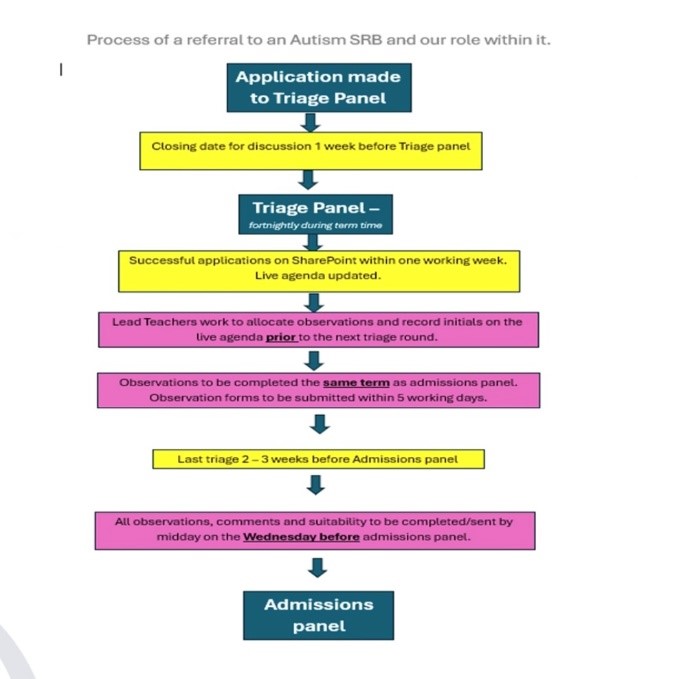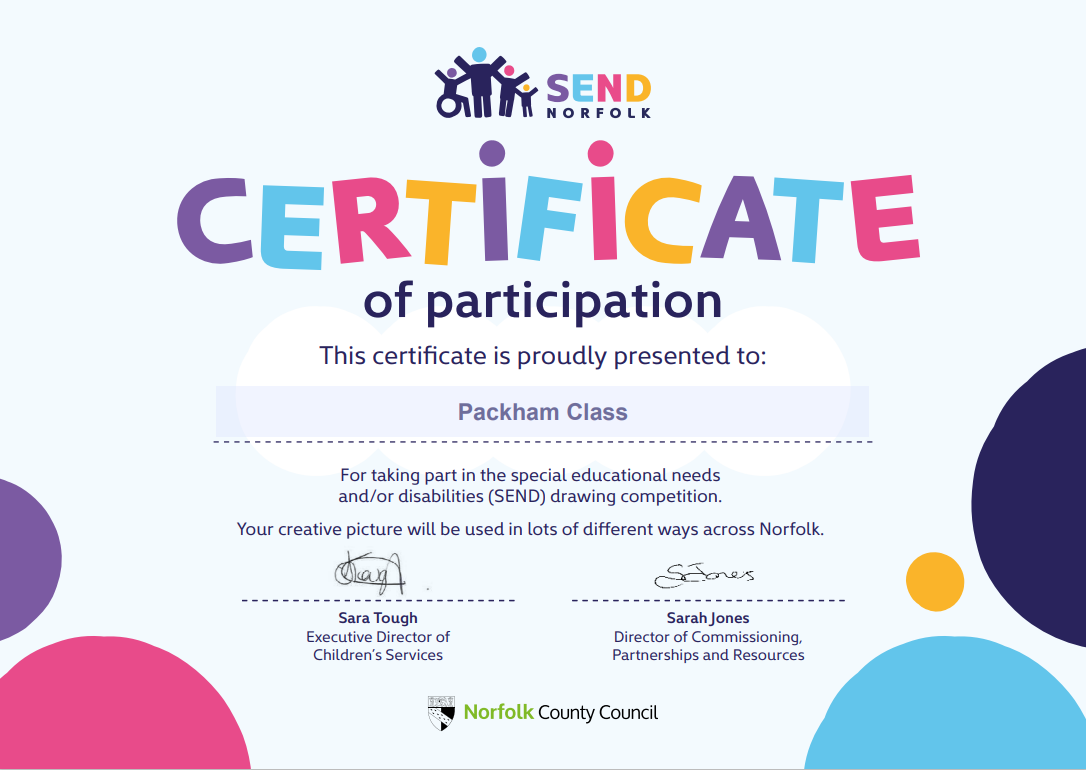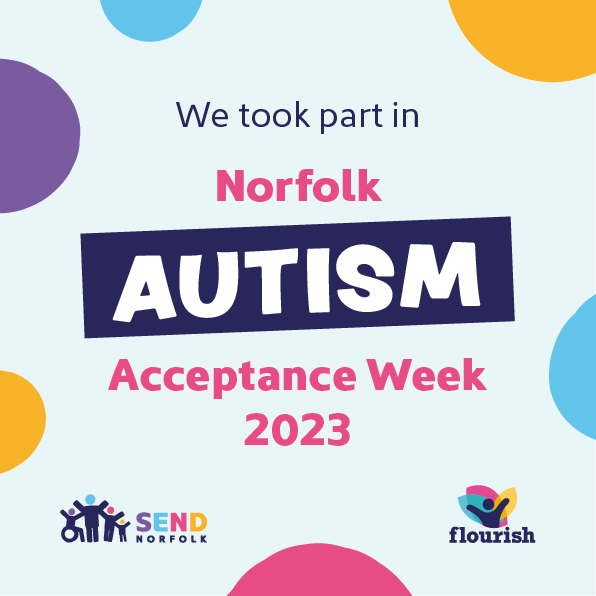ASD SRB Unit – Packham
About us
Welcome to the ASD SRB webpage. We are a base for up to 12 children who have an Autistic Spectrum Disorder diagnosis (or who are on the ASD pathway) across key stage 1 and 2, who need specialist input to enable them to overcome barriers to accessing mainstream lessons.
An individual and gradual approach is taken to integrating the children into mainstream classes and they are assigned a main school classroom as well as the SRB classroom. The children benefit from a low stimulus work environment within the SRB which is attached to the main school and is a safe secure space divided into appropriate spaces such as chill out areas and learning environments adapted to the children’s needs which can be accessed during their school day.
Why Apply
Applications should be made if the school-based interventions at a child’s home school are not proving effective in supporting their progress in line with their assessed ability. Pupils are not required to have an EHCP (Education, Health, Care Plan) to join the SRB.
How to apply
Schools can apply for a child to attend the SRB by completing the online referral form on the Norfolk Schools website: https://www.schools.norfolk.gov.uk/pupil-needs/special-educational-needs-and-disabilities/send-provision-services/specialist-resource-bases-srbs/make-a-referral. A panel meeting happens once every term to discuss suitability of a placement and to assign places should they be available.
The first step in the application process is for the home school and the child’s parents to contact the SRB Lead Teacher (Miss Leach) to have a discussion about the child and their current support package. The home school will then be required to complete the SRB referral form which will then be sent to the triage service.
All referrals to any SRB type is now via a triage process before adding to an admissions agenda for further consideration. An initial screening is completed from the referral form and professional advice to ascertain if child is possibly suitable for the SRB referred for or another type or not at all. Triage panel meet every two weeks and is attended by Head of Specialist Provision and Funding, Senior Educational Psychologist , Specialist partners/Advisors from L&C, SEMH, Autism & SHIPs, Inclusion Team member. If it is decided at triage that a child MAY be suitable for an ASD SRB then they will be moved to the panel list of the nearest SRB and their referral form sent to the SRB lead to consider. If not suitable a letter is sent to parents and referrer within two weeks of triage.

If a child is placed onto our panel list for consideration then a discreet observation will be made in their home school before the panel date and parents/carers will be invited to look around the school. THIS DOES NOT MEAN A PLACEMENT HAS BEEN AGREED AT THIS TIME.
Learners who access provision through the SRB will typically fit the following profile:
· Are in the age range appropriate to the SRB.
· Have a primary diagnosis of ASD, although related diagnoses could also be considered (irrespective of the terminology of the diagnosis the learner will exhibit significant
difficulties in the triad of communication, socialisation and flexibility of thinking which hinder or prevent them from engaging in mainstream education)
· Are likely to hold an Education Health & Care Plan, but this is not necessary for placement
· May have emerging or unmet social, emotional and/or mental health needs in addition to ASD and will not be the main need.
· Have the underlying cognitive ability to access a mainstream school curriculum once barriers to learning have been addressed
· Would not usually meet the criteria for a complex needs school
· Have high levels of anxiety related to confusion and/or fear of what is happening in the immediate environment such that the ability to learn is severely compromised
· Have extreme difficulties in the understanding and acceptance of age-appropriate social rules governing, for example, turn-taking, collaborative activities and the sharing of adult attention
· Have a lack of awareness, to a greater or lesser extent, or even apparent disregard of personal safety and that of others
· Experience considerable, persistent and pervasive problems in establishing and sustaining relationships with peers
· The absence of other primary reasons or causes for these difficulties
Please note that the ASD SRB is not a dual placement but a permanent placement where the children move onto the role of Nelson Academy until the end of year 6.
Timetable
Our SRB staff and main school teachers will use various strategies to adapt children’s access to the curriculum, this might include using:
-
Visual timetables
-
Writing frames
-
I-pads, laptops or other alternative recording devices
-
Clicker 7
-
Tracking and supporting pupils on Norfolk Assessment Pathways (NAP)
-
Peer buddy systems
-
Positive behaviour rewards system.
-
Dojo Points.
-
Zones of regulation.
Each learner identified as having SEND and in the SRB, is entitled to support that is ‘additional to or different from’ a normal differentiated curriculum. The type of support is dependent on the individual learning needs, and is intended to enable access to learning and overcome the barrier to learning identified.
Interventions
What is Forest School?
Forest Schools is a brand of learning that has a wide range of benefits. In the forest school philosophy, children interact with a natural landscape and each other to learn social and technical skills. There is a big focus on developing confidence, self-esteem, and independence.
What are the key skills that it promotes?
Many, although not all, of the key skills developed by forest school can be linked to personal and social development. The main skill sets are the following:
- Discipline
- Self-awareness
- Empathy
- A positive mental attitude
- Self-esteem
- Teamwork
- Independence
- Confidence
What are its other benefits?
- Children learn how to live a healthy lifestyle
- They form excellent relationships with others
- They develop their speaking and communication skills at an accelerated rate
- They learn to manage risks
- They learn about the environment
- They understand features of nature
What is Lego Therapy?
Lego-based therapy is an evidence-based approach that aims to develop social communication skills in autistic children, such as sharing, turn-taking, following rules, using names and problem-solving. Lego therapy interventions can be an option for children who have difficulties with:
- Communication and language
- Social skills e.g making friends
- Expressing how they feel
- Problem-solving activities
- Sticking to a task
- Teamwork
- Fine motor skills
- Understanding and following instructions.
Many benefits can be brought into the lives of young people and children through Lego therapy interventions, including:
- Communicate with others effectively
- Use improved social skills
- Solve problems using different strategies
- Identify and discuss their feelings
- Persevere and be resilient when something isn’t achieved first time
- Use improved fine motor skills
- Understand and follow instructions
- Work as part of a team
- Effectively use spatial, visual, and analytical skills
In practice, children work in groups of three with each participant having a distinct role to build a Lego model collaboratively:
- Engineers use the Lego instructions and ask the Supplier for the specific pieces of Lego needed.
- Suppliers gives the Builder the pieces.
- Builders follow the building instructions from the Engineer to construct the model.
What is Emotional Literacy?
Emotional literacy is a developed awareness and understanding of our own and others' emotions. This guides our thinking and is expressed in our communication and behaviour. Emotional self-awareness is the ability to know ourselves and understand our own feelings.
Teaching emotional literacy is important for developing self-confidence, for boosting self-esteem, for social and emotional development and for encouraging emotional self-management over impulse reactions. Developing emotional literacy aids a child's mental health as well as physical health as both are inextricably linked. There will always be pupils in school facing life challenges that affect their ability to engage with learning and some will require greater support than others to increase their emotional literacy. Emotional literacy support is an intervention programme, designed to support the emotional needs of pupils in school. It recognises that children learn better and are happier in school if their emotional needs are also addressed.
What is an ELSA and what is their role?
An Emotional Literacy Support Assistant (ELSA) is a specialist teaching assistant who has attended a full ELSA training course delivered by one or more fully qualified educational psychologists. They are trained to plan and deliver programmes of support to pupils in school who are experiencing temporary or longer term additional emotional needs, for example: anxiety, low self-esteem, reduced social or friendship skills, anger management, loss, or bereavement. Sessions are fun and we use a range of activities such as games, role-play with puppets or therapeutic activities such as mindfulness or arts and craft. We are not here to fix pupils' problems but what we can do is provide emotional support. We aim to establish a warm, respectful relationship with a pupil and to provide a reflective space where they can share honestly, their thoughts and feelings.
What are Life Skills?
Certain skills may be relevant to you depending on your life circumstances, your culture, beliefs, age, geographic location, etc. However, in 1999, the World Health Organization identified six key areas of life skills:
- Communication and interpersonal skills. This broadly describes the skills needed to get on and work with other people, and particularly to transfer and receive messages either in writing or verbally.
- Decision-making and problem-solving. This describes the skills required to understand problems, find solutions to them, alone or with others, and then take action to address them.
- Creative thinking and critical thinking. This describes the ability to think in different and unusual ways about problems, and find new solutions, or generate new ideas, coupled with the ability to assess information carefully and understand its relevance.
- Self-awareness and empathy, which are two key parts of emotional intelligence. They describe understanding yourself and being able to feel for other people as if their experiences were happening to you.
- Assertiveness and equanimity, or self-control. These describe the skills needed to stand up for yourself and other people and remain calm even in the face of considerable provocation.
- Resilience and ability to cope with problems, which describes the ability to recover from setbacks, and treat them as opportunities to learn, or simply experiences.
The term ‘Life Skills’ refers to the skills you need to make the most out of life. Any skill that is useful in your life can be considered a life skill. Tying your shoelaces, swimming, driving a car and using a computer are, for most people, useful life skills. Broadly speaking, the term ‘life skills’ is usually used for any of the skills needed to deal well and effectively with the challenges of life.
Life Skills we cover include:
- How to make a sandwich
- How to tie our shoelaces
- Trying different foods
- Basic First Aid
- How to look after our personal hygiene
- Road safety
- Budgeting
- How to follow a recipe
What is Sensory Processing and how is it supported?
Sensory Integration is the process by which the brain receives, organises, and processes all the information received from the senses. The senses include touch, sight, hearing, smell, taste, body position and movement (proprioception) and balance/position against gravity (vestibular). The information received from these senses help us to make sense of the world. Effective sensory integration and processing enables us to respond appropriately to different stimuli in our environment and informs our everyday functioning. An inability to effectively process, organise and correctly interpret sensory information is known as Sensory Processing Disorder (SPD). Children with SPD may find functional daily activities challenging. The severity of these difficulties can vary greatly.
If a child is having difficulties with sensory processing, we may see:
- A child who doesn’t like to be touched by others
- A child who refuses to engage in messy play
- A child who appears constantly anxious
- A child who is half asleep, needs to be prompted to engage in a task
- A child who avoids moving, climbing, swinging, or sliding
- A child who puts their hands over their ears and complains of noise
- A child who becomes easily overly excited
- A rigid, stiff, and tense child
- A child who must always touch objects, people, constantly fiddles
- A child wh can’t sit still and constantly fidgets A child who likes to run around.
Such behavioural clues can indicate that a child is not fully ready for learning. This is where sensory circuits can help.
What is a Sensory Circuit?
A sensory circuit is a form of sensory integration intervention. It involves a sequence of physical activities that are designed to alert, organise, and calm the child. The sensory circuit aims to facilitate sensory processing to help children regulate and organise their senses to achieve the ‘just right’ or optimum level of alertness required for effective learning. The circuit should be an active, physical, and fun activity that children enjoy doing. Sensory circuits are a great way to both energise and settle children so they can focus and engage better in the classroom. Many children can benefit from attending a sensory circuit, even for a short period of time. The activities can also be utilised at different times of the day as part of a sensory diet to help the child regulate.
Sensory circuits are designed to start with alerting activities, move to an organising phase and then finally to a calming phase. Doing the activities in the recommended order is vital. The right order results in a well-regulated, happy child. The wrong order may well result in a dysregulated, upset, or irritable child and have the opposite effect.
Alerting
The aim of this section is to provide vestibular and proprioceptive stimulation within a controlled setting. This prepares the brain for learning and the demands of the school environment. Example activities: Jumping/bouncing on a trampoline, skipping, running, rolling, and bouncing on a yoga ball, animal walks, step ups, star jumps etc.
Organising
This section includes activities that require motor sensory processing, balance, and timing. These activities help improve focus and attention. The child needs to organise their body, plan their approach and do more than one thing at a time in sequential order. Example activities: Balancing, climbing, log rolls, throwing to a target, wobble boards, weaving in and out of cones, throwing and catching, jumping through hoops etc.
Calming
The calming activities are very important as they provide input to ensure that children leave the circuit and return to their classrooms calm, centred and ready for the day ahead. Example activities: Proprioceptive and deep pressure e.g., yoga ball squashes, lying under a weighted blanket, massage arms/legs, linear swinging or rocking, heavy muscle work e.g., crawling through a tunnel, press ups etc.
For most effective outcomes, sensory circuits should be completed on a regular basis. Ideally, the circuit will take no more than 15-20 minutes. The children should spend up to 5 minutes in each section performing the different activities.
It is important to consider that each child’s needs and tolerance levels are different. Some children may need more time in the alerting or calming sections to enable them to be more organised and prepared for the day’s learning. Children should be encouraged but not forced to participate in the circuit and must always be supervised.
Swimming
Many children with autism are drawn to water for its calming, sensory experience. In fact, a 2015 study found that children with ASD enjoy swimming significantly more than children without ASD. And while water can present a safety concern, water play and swimming also offer several benefits for children with ASD.
- Leisure skills
- Physical health
- Creativity and imaginary play
- Social time
- Learning to be safe in the water and around it
- Supports SPD
- Helps to moderate levels of excitement or anxiety
Transition
Transition is a part of life for all learners. This can be transition to the SRB, a new class in school, having a new teacher, or moving on to another school. Nelson Academy is committed to working in partnership with children, families and other providers to ensure positive transitions occur. Planning for transition is a part of our provision for all learners with SEN. Transitions will be discussed with parents, children and staff. Transition to secondary school will be discussed in the summer term of Year 5 to ensure there is time to plan and prepare.
SRB Network
The Lead Teacher from Packham class attends the ASD SRB network meetings to liaise and share best practice with professionals working within similar settings and specialist provision. As part of this network, all staff working within the SRB can access specialist training. We have a specialist partner that comes in to support staff, observe and provide additional training as well as a designated Educational Psychologist and EHCP Coordinator. Please see the Norfolk site for further information: www.norfolk.gov.uk/srbs
At Nelson Academy SRB, we are committed to working together with all members of our school community. Our SRB offer has been produced with pupils, parents/carers, governors, and members of staff. We welcome your feedback and future involvement in the review of our offer, so please do contact us.
Should you wish for any further information, please contact Miss Leach on 01366 383824 or via email cornelia.leach@nla.eastern-mat.co.uk
If you have specific questions about the Norfolk Local Offer please look at the Frequently Asked Questions by clicking here https://www.norfolk.gov.uk/children- and-families/send-local-offer


